Sunday, May 4, 2014 | 2 a.m.
Sporting events produce some of life’s most euphoric and heart-breaking moments. They can make your heart race with excitement or anxiety, reward you for hanging in there with the team or disappoint you by snatching victory away at the last possible moment.
And that’s just for the fans.
So imagine what it’s like for the competitors to hit the game-winning shot, for coaches to get the Gatorade bath, or for a fighter to have to admit to himself that he’s lost a match and concede defeat. We wondered what it’s like, so we asked. And they told us.
These are their stories.
What it's like ...
-
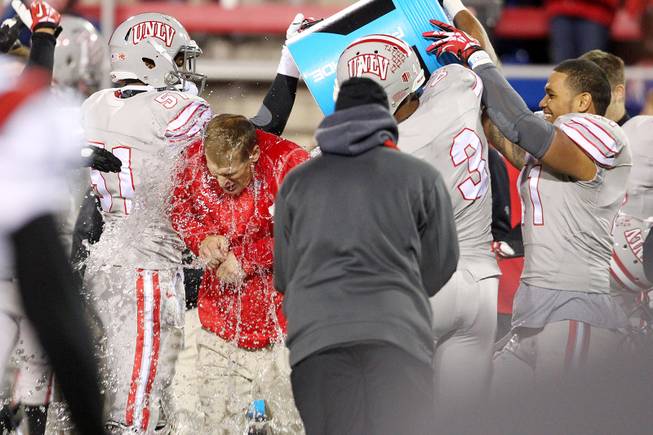
... to get a Gatorade bath in a football celebration (on a cold day)
UNLV football coach Bobby Hauck never saw it coming.
Even though the Rebels were comfortably ahead and about to secure bowl eligibility for the first time in 13 years, Hauck was still focused on the game and not freezing in the Colorado Springs air. The wind chill was below zero that night.
“It didn’t occur to me that they were going to do it,” Hauck said.
And then they did. A few Rebels grabbed a giant water jug from the sideline and doused Hauck in celebratory fashion.
Dumping Gatorade or ice water on a coach is a fairly common practice for big victories these days. But even for Hauck, who took some awfully cold baths after rivalry wins in Montana, this drenching in “nasty cold” weather was a case of extremes.
“All of a sudden you go from being focused on the game to being ice cold,” he said. “I didn’t thaw out until an hour later.”
That was one of four on-field baths Hauck received during the 2013 season, although it was the only one that probably required a doctor visit afterward.
“It’s a sign of affection,” Hauck said, “but it was so cold, though.”
-
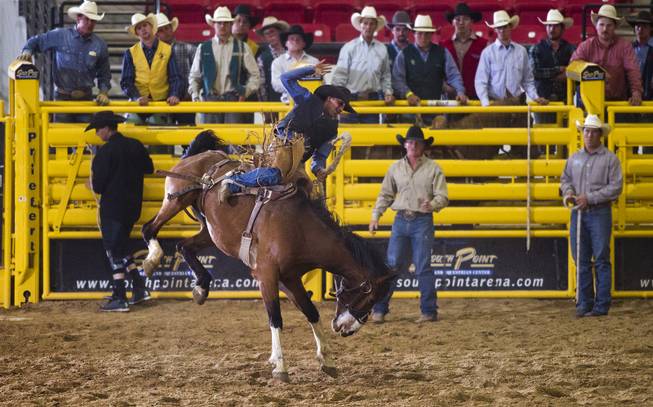
... to get bucked off a bronco
The first time Tyler Baeza was bucked off a bronco, he broke his pelvis and tore a hamstring. Last fall, Baeza broke five bones in his back, sidelining the UNLV junior from saddle bronc competition until February.
Between those setbacks, Baeza discovered — and then spent a lot of time chasing — the adrenaline high.
“There is no greater feeling than riding a bucking horse,” Baeza said. “I guess you could compare it, if you ride one and win a big rodeo, to shooting that buzzer beater or throwing that touchdown in overtime.”
To score points, a rider must last eight seconds on the horse. The more challenging the ride, the higher the possible point total.
When the ride is going well, with rider and horse moving as one, the feeling of power is intoxicating. Of course, part of the rush is the fleeting moments of controlling the uncontrollable, and as Baeza can attest, it can go bad quickly.
A last-second shot often feels, to fans at least, like it’s hanging in the air forever. The same could be said for a cowboy bucked off his horse, only it doesn’t feel that way for the person crashing to reality.
“Once you’re off the animal,” Baeza said, “you’re going to hit the ground in a hurry.”
-
__t653.jpg?214bc4f9d9bd7c08c7d0f6599bb3328710e01e7b)
... to get submitted in an MMA fight
The top-ranked welterweight contender in the UFC is intimately familiar with the sensation of losing a fight via submission.
Robbie Lawler has lost five bouts by submission throughout his professional career, including a third-round rear-naked choke against Brazilian jiujitsu ace Ronaldo “Jacare” Souza in a Strikeforce title fight three years ago. While having to tap out is mentally anguishing, Lawler says it isn’t as physically devastating as outsiders would believe.
“It’s almost like, not a word I normally use, but shucks,” Lawler said. “You’re just caught. You’ve got to tap out if you don’t want something broken or to go to sleep.”
Some fighters would rather get choked unconscious or suffer a heinous injury than surrender. They consider the mindset part of their warrior spirit. UFC women’s bantamweight champion Ronda Rousey, notably, has broken the arms of five opponents who refused to tap out from her armbar.
Lawler, who next fights Jake Ellenberger at UFC 173 on May 24, never understood the stubbornness.
“Let them be tough, but me, I’m going to tap,” Lawler said. “If I know I can’t get out, there’s no reason in going to sleep or getting seriously hurt. I’m not going anywhere in my career so I might as well get out of there in one piece and use it to learn and get better.”
-

... to complete an ultramarathon
Summerlin’s Molly Sheridan kept running.
The minutes turned into hours. The hours turned into days. The altitude became unbearable and fatigue caused her to hallucinate. But she didn’t stop.
She was the first American woman to complete the 137.64-mile nonstop La Ultra-The High ultramarathon in the Himalayas, battling the snowy peaks course with elevation climbs from 14,000 feet to 18,000 feet in 57 hours.
“I don’t say, ‘I’m going to run 138 miles today.’ Nobody does,” Sheridan, 57, says. “It can be overwhelming mentally. I break it off into small, little pieces. Let’s make it the first 10 miles, then another 10 miles.”
If it were only that easy.
The Himalayas, the Asian mountain range in India between China and Pakistan, are unforgiving to competitors, who arrive two weeks before the race to adjust to the altitude. It’s so dangerous the Indian government said the race is physically impossible to complete.
Sheridan and two others proved that theory wrong in 2011.
“It was so exciting, so unpredictable,” she said. “Ninety percent of it is the mental power to get to the finish line. The human body can do so much more than you realize.”
She had a crew next to her with supplies, stopped to change clothes and even laid down to rest a few times on the road. The event requires competitors to reach certain points on the course in a required time to continue.
“You run, you walk, you do whatever it takes to get to the finish,” she said.
At about 17,000 feet, she began hallucinating, seeing someone doing cartwheels near her support vehicle. But she kept running.
“It was fatigue; I can deal with fatigue,” she wrote on her blog shortly after.
Ultramarathons, or any race over the marathon distance of 26.2 miles, are considered extreme by some. Sheridan has competed in more than 30 around the globe, considering herself an adventurer, not a runner.
“To me, it is a grand adventure. All of them are to test yourself,” she said. “I’m not one for extreme. I’m really protective of my health and fitness. I would never hurt myself. It’s an exploration of nature, myself and my mind.”
-
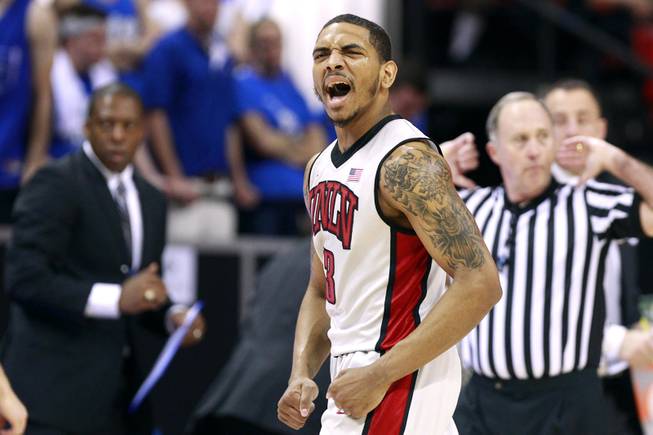
... to hit a game-winner
Growing up, Anthony Marshall did what pretty much every other kid who’s ever picked up a basketball did. He would count down a few seconds and heave an imaginary game-winning shot.
It turned out to be practice.
“Those are the moments you live for as a small child,” Marshall said. “Being in the moment like that, it felt tremendous. That was something I always wanted to do.”
The Mojave High and UNLV grad doesn’t have a legit buzzer beater to his credit — the rare game-winner that falls through with no time on the clock — but in his senior season he got to put those childhood reps to use.
In a tie game at home against Colorado State, Marshall dribbled down the clock and made his move off a screen with 15 seconds left. If a double team came, Marshall said he had options in the corners, but honestly it would have taken a lot to give up that ball.
“I wanted to take that shot because, being the leader of the team, I was man enough to take the blame,” Marshall said.
He raised into the air, falling off balance about 15 feet from the basket. A defender was right in his face but it mattered not as the ball swished through with nine seconds remaining.
Marshall knew it was good out of his hands. And unlike on the playground, he didn’t have to pretend the crowd was going wild.
“You grow up envisioning yourself always completing that shot,” he said.
-
... to be the last player eliminated at the World Series of Poker
Streamers and confetti rained down at the front of the stage. Ryan Riess, crushed underneath a pile of friends and family, rejoiced becoming poker’s world champion and earning the $8.36 million prize stacked nearby.
On the other side was local nightclub promoter Jay Farber with his head down, taking little solace in the $5.17 million second-place payout last year.
“It’s an incredible accomplishment, but it’s also the worst thing in the world because once you’re there, all you want to do is win,” he said.
Winning the Main Event doesn’t seem possible in the beginning of the summer, when more than 6,000 pack the cavernous convention rooms at the Rio. Even when the final table of nine reconvened in November, Farber said looking ahead wasn’t an option because of the level of competition.
“The only people who could understand would be guys who have lost a championship game, been to a Super Bowl and lost or my buddies who took second place,” he said.
Talking with friends Jesse Sylvia and David Williams, who came in second in 2004 and 2012, respectively, helped Farber cope. In the end, the state of Farber’s bank account helped too.
“The pain has lessened over time,” Farber concluded. “Looking back, I would still love to say I’m the world champion but for a couple weeks I was really beaten up over it. I’ve moved on from that.”
-
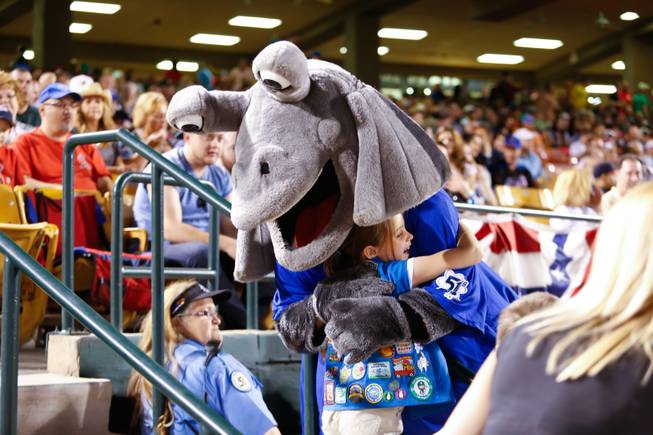
... being a mascot in the heat
Cosmo, the Las Vegas 51s plumpish and fun-loving mascot, is easily spotted on game days at Cashman Field.
He scurries around the stadium making sure fans enjoy a night of minor league baseball, rotating between participating in on-field promotions and posing with fans for photos in the bleachers.
During the summer, when Cosmo is seen leaving the field via the tunnel in the visitor’s dugout, he’s on another mission: Grabbing a drink.
The multi-layered costume weighs about 25 pounds. For most games during the summer, the temperature at first pitch is over 100 degrees.
“You’re sweating bullets. My undershirt sticks to my skin,” said Jay Basile, one of three who rotate game-by-game duties playing Cosmo.
First there’s the “fat suit,”then the gray-fur exterior suit. There’s also oversized shoes, similar to what a circus clown would wear.
Basile, 25, wears basketball shorts and a long-sleeve mesh shirt underneath. Cosmo doesn’t talk to fans, nor can they see him sweat.
“We know our limits and how far we can push ourselves,” Basile said. “The 51s organization makes sure we stay safe.”
Precautions include a hydration station with water and Gatorade in the tunnel. There’s plenty of shade and air conditioning, too.
The outfit, just like the person wearing it, gets sweaty. After games, it’s hung in a storage closet and sprayed with Febreze to hedge the odor. Officials take the outfit to the cleaners once the team leaves for a road trip.
Sunday games are the worst in dealing with the heat because start times are in the afternoon. The three love being part of the pageantry, but dread being assigned those afternoon games.
“We’ll play rock-paper-scissors for it,” Basile said.
-
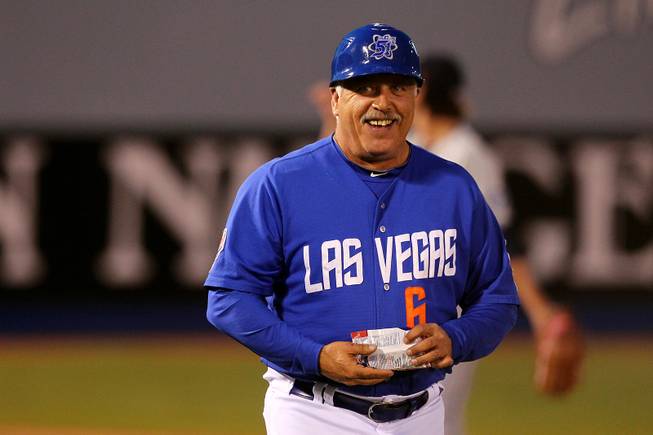
... to be part of one of baseball's most memorable games
Las Vegas 51s manager Wally Backman is frequently asked about this night at Shea Stadium. He was front-and-center for one of baseball’s all-time memorable plays, when his New York Mets miraculously beat the Boston Red Sox in Game 6 of the 1986 World Series after Billy Buckner let a ground ball go through his legs at first base, allowing the winning run to score.
“I was sitting on the bench in disbelief. It was unbelievable,” said Backman, the former Mets’ second baseman. “That is why baseball is such a great sport. It isn’t over until it is over.” (The Mets would win again the following night to take the series.)
They trailed by two runs with two outs in the 10th inning, and by the time Mookie Wilson’s grounder took an awkward bounce and slipped under Buckner’s legs, some fans had left the stadium. Ray Knight scored the winning run from second base, putting the finishing touches on one of the sport’s wildest comebacks.
“That’s baseball,” Backman said.
-
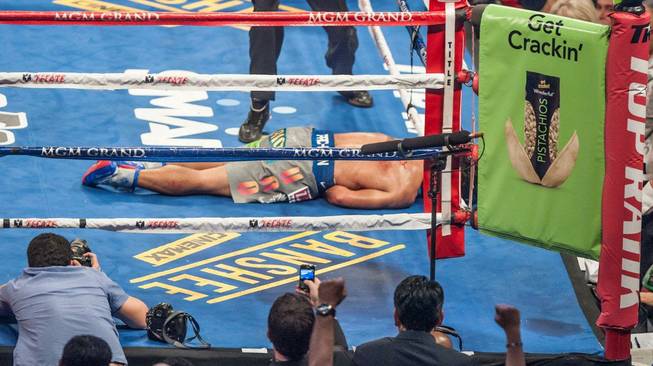
... to get KO'd in a boxing match
After a brutal knockout, a boxer is often depicted as completely disoriented.
Movies, for instance, show fighters as unaware of their surroundings after regaining consciousness and remembering little of what happened. But that’s not always the case in real life.
In fact, the likely Knockout of the 21st Century to this point deviates from the established trope. Manny Pacquiao’s corner rushed to his aid after Juan Manuel Marquez left the legendary Filipino fighter face down on the canvas with a counter right in the sixth round of their December 2012 bout.
When Pacquiao awoke, his demeanor wasn’t all that different from normal.
“I remembered what happened,” Pacquiao said. “I wanted to get up and congratulate him.”
Pacquiao felt disappointed for getting “careless” after finding success in the fight, but wasn’t saddled with the scarier effects of losing by knockout. It was the third knockout loss of Pacquiao’s career, but the first in more than 13 years.
It will go down as the most memorable because of the stakes. The fight was Pacquiao’s fourth against Marquez, with hundreds of thousands watching via pay-per-view, and was his first legitimate loss since rising to international superstardom.
None of that makes Pacquiao ashamed. He came to terms with the possibility of knockouts when he first started boxing at 14 years old.
When he met current trainer and Boxing Hall of Fame honoree Freddie Roach, the first two tapes Pacquiao showed him were of knockout losses in the Philippines. A stunned Roach asked why Pacquiao chose those fights and will never forget the fighter’s answer.
“It’s part of my life,” Pacquiao told Roach. “It’s part of boxing.”


__t653.jpg?214bc4f9d9bd7c08c7d0f6599bb3328710e01e7b)


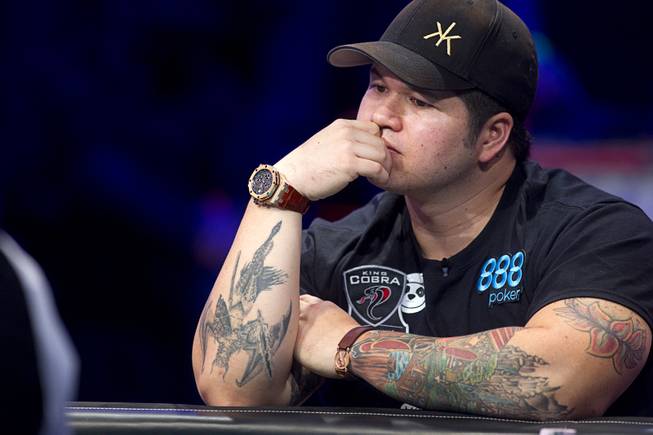




Join the Discussion:
Check this out for a full explanation of our conversion to the LiveFyre commenting system and instructions on how to sign up for an account.
Full comments policy